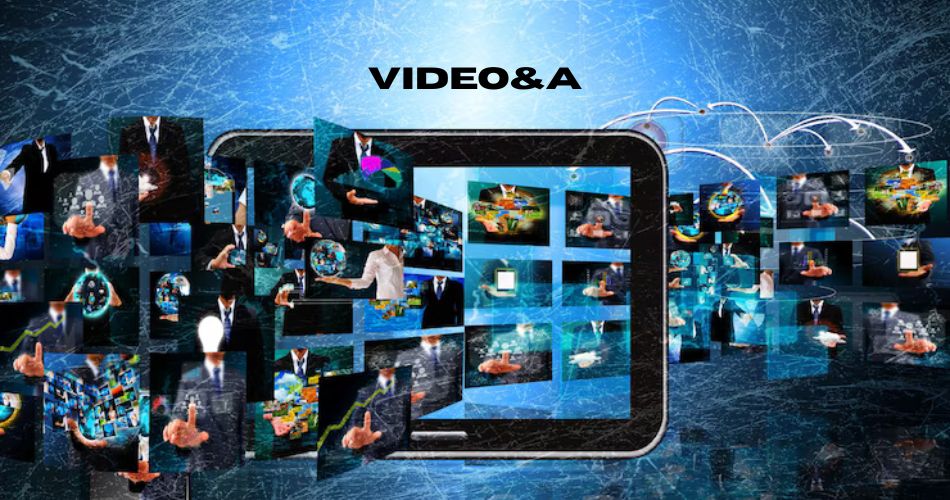The term Video&A refers to a modern digital trend that fuses video and audio into a unified media experience, aiming to deliver content in a format that is more immersive, accessible, and engaging for a diverse audience. Unlike traditional formats where users either watched videos or listened to audio content separately, Video&A combines both elements seamlessly. This convergence is not just a technical improvement but a creative evolution that empowers content creators, marketers, educators, and everyday users to tell stories, share information, and entertain with greater depth. As digital consumption habits evolve, audiences demand content that is rich, interactive, and adaptable to their preferences. Video&A meets that demand by allowing viewers to switch between watching and listening without losing context, enhancing the overall user experience.
The Shift from Traditional Media to Dynamic Content Fusion
Traditional media followed a linear path—TV for visuals, radio for sound. With the internet boom, video streaming and podcasting flourished independently. But in today’s fast-paced world, people want flexibility. Video&A is born out of this demand for fluidity. Whether someone is watching a video lecture and switching to audio while driving, or listening to a podcast that seamlessly transitions into video clips for better understanding, Video&A supports all these use-cases. This synergy of video and audio provides users with control over how they consume content, improving accessibility and engagement. For instance, language learners can benefit from subtitles in videos while listening to pronunciation, or professionals can tune into video podcasts with visual cues during workouts or travel.
How Video&A is Enhancing Content Creation and Delivery
For content creators, Video&A opens a world of opportunities. Instead of producing separate formats for video and audio, creators can now design content that performs on both fronts, saving time and maximizing reach. Platforms like Spotify and YouTube are already encouraging this shift by supporting video podcasts and auto-generated subtitles. Additionally, AI tools are making it easier to edit both media types together—synchronizing audio tracks with visual frames, adding interactive elements, and translating speech into text for accessibility. This holistic approach also boosts content quality, as creators are pushed to consider not just what their audience sees, but what they hear and feel. From music videos and vlogs to news reports and tutorials, the storytelling possibilities are endless when both audio and video are leveraged thoughtfully.
Video&A and Its Role in Marketing and Branding
In the world of digital marketing, attention is currency. Brands are investing in Video&A strategies to capture and hold user interest across platforms. Short-form videos on platforms like TikTok and Instagram Reels combine catchy audio with dynamic visuals, making them memorable and shareable. Meanwhile, long-form branded content—like interviews, case studies, and documentaries—is being produced in dual formats to cater to both video and podcast audiences. This duality not only increases reach but also improves brand recall, as consumers are more likely to remember content that appeals to multiple senses. Additionally, Video&A supports accessibility efforts, helping brands reach visually impaired users with descriptive audio, or those with hearing challenges through captioned content.
Educational Advancements through Video&A Technologies
Education is one sector where Video&A is showing transformative potential. Online learning platforms are increasingly using Video&A formats to enhance learning outcomes. Students can watch a science experiment while listening to a detailed explanation or revisit lecture audio during their commute. Tools like screen recordings with voice-over tutorials, animated explainers with narration, and live webinars with visual aids are now standard practices. More importantly, Video&A enables inclusive education by providing subtitles, descriptive audio, and multi-language translations in real time. Institutions adopting this format are seeing improved engagement and retention, as learners can choose how they absorb information—visually, audibly, or both.
Entertainment Gets an Upgrade with Video&A
In entertainment, the rise of Video&A has pushed the boundaries of how stories are told and consumed. Music artists release video albums, podcast hosts integrate video segments, and streaming services offer content with optional audio-only modes. This versatility enhances viewer freedom while deepening their connection to the content. For example, fans can watch a behind-the-scenes music video and switch to just listening while multitasking. Similarly, gaming content, once dominated by either visuals or commentary, now thrives on platforms like Twitch, where video streams and interactive voice chats co-exist. The immersive quality of Video&A also makes it a perfect fit for emerging technologies like virtual reality (VR) and augmented reality (AR), where synchronized audio-visual elements create lifelike experiences.
Technical Foundations Powering Video&A Innovation
Behind the scenes, Video&A relies on advanced codecs, real-time rendering engines, and AI-based enhancements to merge video and audio seamlessly. Codecs like AAC and H.264 allow for efficient compression without sacrificing quality, while platforms like FFmpeg help encode multimedia content. AI tools can now automatically transcribe spoken words, translate them, and generate subtitles or voiceovers. Cloud-based platforms further simplify collaboration, allowing teams to edit video and audio layers simultaneously from different locations. These technologies not only support content creation but also ensure smooth playback across devices and bandwidth levels. This means users in different regions and with varying internet speeds can still enjoy a rich Video&A experience without delays or quality loss.
Popular Platforms Paving the Way for Video&A Integration
Several major platforms are embracing the Video&A trend. YouTube now allows podcast uploads with video enhancements, Spotify supports video podcasts and live streams, and platforms like TikTok prioritize audio-driven video content. Meta’s Instagram and Facebook Reels are also optimizing for video-audio convergence, making it easier for creators to include trending music and sound bites. Educational platforms like Coursera and Udemy are including video lectures with audio downloads. These integrations make it evident that the industry is moving towards a unified content model where the boundaries between video and audio are disappearing.
Video&A for Accessibility and Inclusion
Accessibility is a major benefit of the Video&A format. People with visual impairments can access descriptive video content through well-produced audio narratives. Conversely, those who are deaf or hard of hearing benefit from synchronized captions and visual cues. By blending these formats, creators can ensure their content reaches everyone, regardless of physical ability or language barriers. Tools that convert text to speech, speech to text, and automatically generate captions are helping bridge the accessibility gap, enabling more inclusive content consumption.
Challenges Facing the Video&A Ecosystem
Despite its advantages, the Video&A approach isn’t without challenges. Not all platforms are optimized for dual media consumption, and producing content in both formats requires more planning and resources. Licensing issues around music and video clips can also create legal complications. Additionally, users in areas with limited internet access may struggle to stream high-quality Video&A content. These limitations, however, are being addressed through better compression technologies, offline content options, and more streamlined production tools.
The Future Potential of Video&A Across Industries
The future of Video&A is bright and expansive. We can expect AI-driven personalization that adapts audio tones, subtitles, or visuals based on the viewer’s mood, preferences, or learning style. Integration with virtual reality, holographic presentations, and even brain-computer interfaces may redefine how we consume content altogether. In healthcare, doctors could review patient scans with narrated diagnostics. In e-commerce, product pages may evolve into interactive experiences with video try-ons and voice explanations. As these possibilities unfold, businesses, educators, and creators must prepare to embrace Video&A not as an option but as a standard.
Conclusion
Video&A is revolutionizing how we create, consume, and connect with digital content. By blending the richness of video with the intimacy of audio, this hybrid format offers unmatched flexibility, accessibility, and engagement. From marketing and entertainment to education and inclusion, Video&A holds the key to a future where content adapts to the user—not the other way around. Embracing this trend is not just a matter of innovation, but a necessity in an age where attention spans are short and expectations are high. As tools and platforms continue to evolve, Video&A will define the next chapter in media storytelling and digital communication.
Read More Trending Topic:
- Gimkit: A Fun and Interactive Learning Tool for Students
- Gimkit Join: Revolutionizing Classroom Engagement with Game-Based Learning
- Gimkit Home: Transforming Education with Gamified Learning
- Gimkit Code: A Complete Guide to Enhancing Student Engagement
- Gimkit Host: The Ultimate Guide to Hosting Interactive Learning Games



